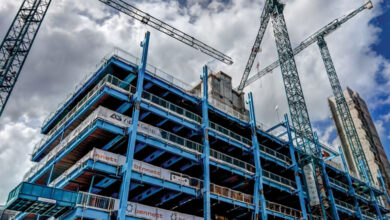Planning for the Environment and Climate

Alma Walsh, senior advisor with the National, Regional and Urban Policy Unit of the Department of Housing, Local Government and Heritage, discusses the evolution of environmental considerations in planning policy.
Setting out the existing legislative and policy framework, enshrined in the Planning and Development Act, which creates a statutory architecture for national policy to inform regional and thereafter local planning decision-making, Walsh highlights the significance of the shift that has already occurred to more sustainable patterns of growth for the whole country, in comparison to the boom-and-bust cycle Ireland had experienced.
The senior advisor explains that the need to shift away from “an era of developer-led approach to planning” underpins the creation of the National Planning Framework, and the requirement for its existence at a national level.
Speaking on the 17 October 2024, the day on which the President signed in to law the Planning and Development Act 2024, the third largest Bill in the State’s history, Walsh explains that the consolidation and revision of the Planning and Development Act 2000, has been a large focus for her department over the past two years.
“The priority for planning, more generally, has been around the implementation of that new Act across the planning system,” she explains.
Walsh outlines that alongside the consolidation and revision of the Bill, the Department has been working to implement and revise the National Planning Framework (NPF), ensuring that it goes across government and through the hierarchy of the planning system – towards a more plan-led system.
An additional priority has been the continued focus on enabling and supporting accelerated housing delivery and climate action.
Planning and Development Act 2024
Outlining some of the key reforms of the Act, Walsh points to the role of the Office of the Planning Regulator in the continued improvement of consistency and alignment throughout all tiers of planning. In addition, Section 28 ministerial statements will be upgraded to National Planning Statements, the cross-cutting nature of which, Walsh explains, will elevate planning considerations right across government.
“Very important to note are the strengthened references to biodiversity and climate change at the National Planning Framework and National Planning Statement levels, emphasising the requirement of integration of the relevant policies and measures, including biodiversity and climate change, of the Government,” she states.
“This is a requirement around integrating the relevant policies and measures of government with specific reference, for example, to the national Biodiversity Action Plan and also to the Climate Action Plan. You can see the Act now integrating and making it a legal requirement, within the planning system, to have a direct relationship and regard to, and to be informed by those particular plans at a national level, which is a critical piece underpinning the approach around environmental protection more generally, and then again, ensuring that our own obligations under the EU directives are also met. As well as ensuring that the Planning Act is fit for purpose and flexible enough to respond to those other statutory, timebound processes that we must comply with, particularly in the area of plan making.”
Pointing to the next steps for the Act, Walsh explains that phased commencement is underway, with existing provisions of the Planning and Development Act remaining in place until the relevant provisions in the Act are commenced. The Department has outlined an intention to publish a comprehensive implementation strategy, including a detailed commencement schedule, and are undertaking preparation of revised Planning and Development Regulations.
“Very important to note are the strengthened references to biodiversity and climate change at the National Planning Framework and National Planning Statement levels.”
Updated Draft Revised NPF
Originally published in 2018, the Government announced a revision in June 2023, framed in the context that the revision is not a full review, but a long-term strategy out to 2040 focused on five key drivers. Walsh points to population and demographic change projections on the back of Census 2022, and recognition of the need to update and adjust the NPF in response to the climate challenge as two critical areas of work.
“This is in relation to the language, but more specifically, to the national planning objectives – those key national objectives that inform the regional and local tiers of plan-making,” she explains. “The strategy needs to reflect those newer commitments such as the sectoral emissions targets, for example, the updated actions of the Climate Action Plan, and, more generally, updating the NPF with the capacity to respond to the climate crisis.”
Highlighting the underpinning objective of the NPF as being of compact growth and balanced regional development, Walsh points to a revised strategy which “by and large” retains the principles and objectives of the underlying 2018 NPF, but which integrates more up to date patterns of development and growth.
“We are keen to ensure that at a local level, the opportunity to allow for further NPF implementation is given, and in recognition that some of the targets are very ambitious in terms of population growth for cities and will require longer term interventions.
“To give effect to those, there is a new element to the strategy in the form of New Sustainable Communities, as well as potential requirement to plan for population growth in line with the ESRI’s high migration scenario of over 6.3 million.”
NPF and the environment
Offering a sense of some of the changes the draft NPF is likely to deliver in relation to the environment, compared to 2018, Walsh says: “We have listened to our stakeholders and taken on board what they have been saying around the topic of environmental capacity. So, even where the population is targeted for growth, there is a reality around the capacity to deliver that.
“This speaks very much to infrastructural investment as much as anything else, so have amended National Policy Objective (NPO) 11 to reflect that and build it into the consideration of development proposals, for example, particularly at planning application stage. This goes beyond the regular planning considerations, and, in particular, takes into account the receiving capacity of the environment. That is a real value added piece to the NPO as we see it.”
Walsh also says that the draft NPF will strengthen policies in relation to biodiversity. “We have built in additional and stronger language in relation to the environmental assessments of the NPF to acknowledge the role of planning in protecting and managing the environment,” she says.
On reflecting and integrating the Climate Action Plan commitments, including in areas such as district heat and renewable electricity, she says: “It is about front loading those commitments into our national planning policy to ensure they filter right through the system.”
Concluding on the preparation of an implementation plan, Walsh says: “Coming out of the revision process, it has been made really clear that implementation is critical for the National Planning Framework, not just at the policy level, but right across government, right across investment planning and right across other sectoral policy areas.”





